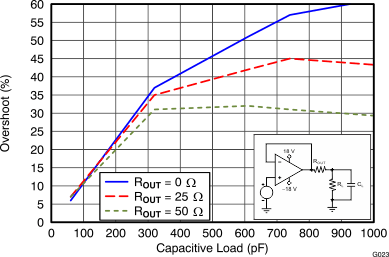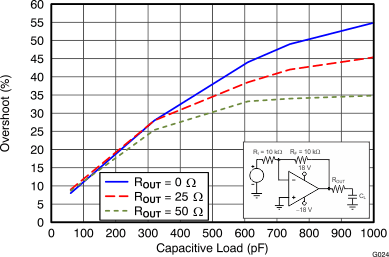JAJSCN6A November 2016 – May 2018 TLV170 , TLV2170 , TLV4170
PRODUCTION DATA.
- 1 特長
- 2 アプリケーション
- 3 概要
- 4 改訂履歴
- 5 Pin Configuration and Functions
- 6 Specifications
- 7 Detailed Description
- 8 Application and Implementation
- 9 Power Supply Recommendations
- 10Layout
- 11デバイスおよびドキュメントのサポート
- 12メカニカル、パッケージ、および注文情報
パッケージ・オプション
メカニカル・データ(パッケージ|ピン)
サーマルパッド・メカニカル・データ
- D|14
発注情報
7.3.4 Capacitive Load and Stability
The dynamic characteristics of the TLVx170 are optimized for common operating conditions. The combination of low closed-loop gain and high capacitive loads decreases the phase margin of the amplifier and can lead to gain peaking or oscillations. As a result, heavier capacitive loads must be isolated from the output. The simplest way to achieve this isolation is to add a small resistor (for example, ROUT equal to 50 Ω) in series with the output. Figure 28 and Figure 29 show graphs of small-signal overshoot versus capacitive load for several values of ROUT. Also, see the Feedback Plots Define Op Amp AC Performance application report for details of analysis techniques and application circuits.

| 100-mV output step, RL = 10 kΩ, G = +1 |

| 100-mV output step, RL = 10 kΩ, G = –1 |